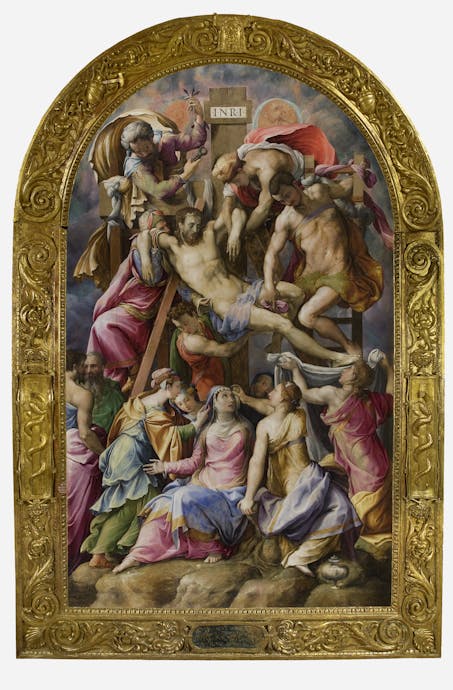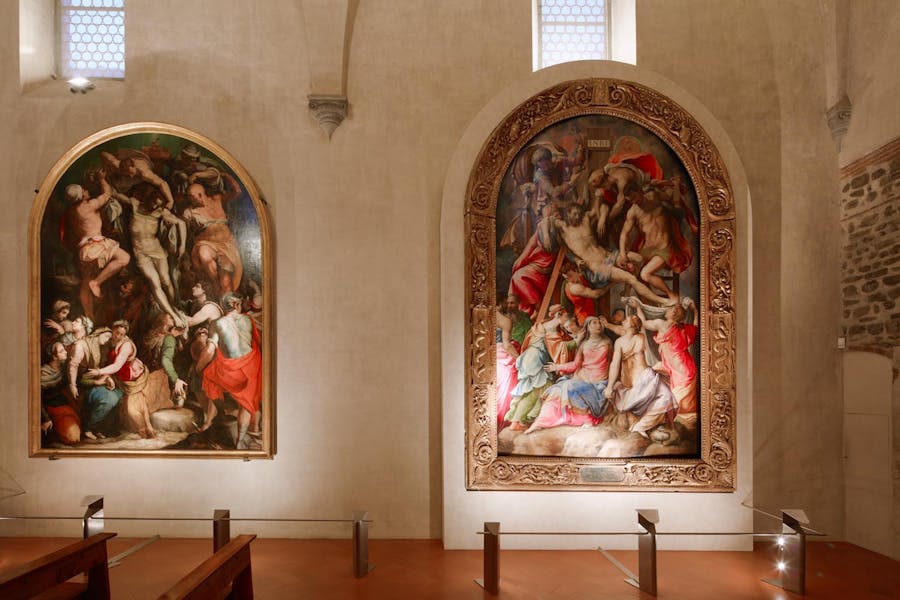Francesco (Cecchino) Salviati

Artist: Francesco (Cecchino) Salviati (Francesco de’ Rossi; Florence 1510 - Rome 1563); Battista di Marco del Tasso (Florence 1500-1555), attributed (frame)
Title: Deposition from the Cross
Date: 1547-1548
Material and tecnique: oil on wood (panel); carved and gilded wood (frame)
Dimensions: 495 x 285 cm (panel); 515 x 346,5 cm (frame)
Position: Novitiate, Medici Chapel
This altarpiece was painted for the Dini family altar situated to the right of the main doorway leading into the church and demolished in 1883 to make way for Giovan Battista Niccolini's tomb.
It was moved to the Refectory, by then a museum, and was severely damaged in the flood of 1966. After complex restoration, it was returned to Santa Croce in 2006 to mark the 40th anniversary of the flood and placed on a structure in the middle of the Refectory along with other restored works of art.

Salviati's Deposition from the Cross in Santa Croce's Refectory
It was moved to its present position in 2014 to avert the risk of flood damage.

South wall of the Medici Chapel. Basilica of Santa Croce
The painting was commissioned by Cosimo I de' Medici's wealthy and powerful henchman Agostino Dini, who lived in nearby Borgo Santa Croce. Writing in 1568, Vasari tells us that Salviati "painted in it Christ taken down from the Cross by Joseph of Arimathæa and Nicodemus, and at the foot the Madonna in a swoon, with Mary Magdalene, Saint John, and the other Maries. This altarpiece was executed by Francesco with so much art and study, that not only is the nude Christ very beautiful, but all the other figures likewise are well disposed and coloured with relief and force". The picture was Salviati's last work in Florence before he left the city for Rome, having received no further commissions from Cosimo I after his decoration of the Audience Chamber in Palazzo Vecchio, whose intensely shimmering colours are reflected in the palette he adopts here.
The frame, which Salviati may have designed himself, is an integral part of the work and may be attributed to the important Florentine workshop of Battista di Marco del Tasso.
The painting brought an astonishing touch of modernity to Santa Croce, which had not yet been renovated by Vasari, but when Bronzino's altarpiece on the altar on the opposite side of the doorway was unveiled in 1552, it suddenly appeared less innovative, although his figures' solemn composure was much appreciated in the cultural climate of the Counter-Reformation.